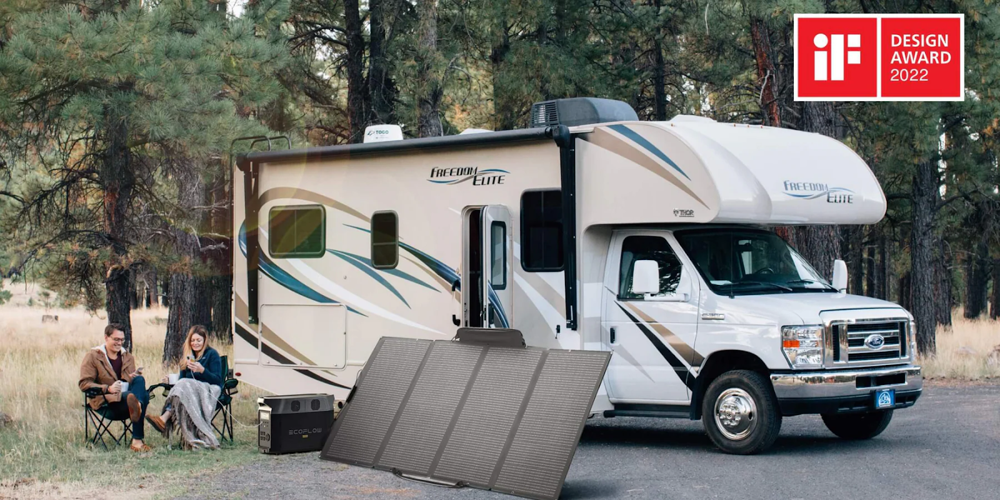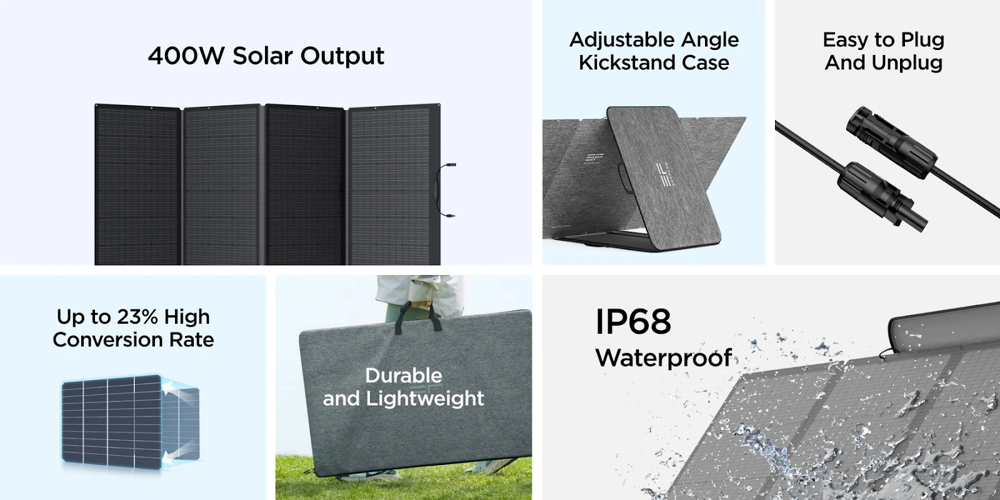As more Canadians embrace outdoor living, remote work, and sustainable energy, portable solar panels are quickly becoming an essential part of modern life. They offer a clean, renewable way to power your electronics—whether you’re camping in Banff, exploring the Yukon, or preparing your home for unexpected power outages.
If you’re new to solar energy, this guide will walk you through everything you need to know: how portable solar panels work, how to choose the right setup for Canadian conditions, and how to use them safely and efficiently.

1. Understanding the Basics: How Solar Panels Work
Before diving into setup, let’s start with the basics.
A solar panel is made up of photovoltaic (PV) cells—tiny pieces of silicon that convert sunlight into electricity. When sunlight hits these cells, electrons begin to move, creating direct current (DC) electricity.
Since most household and camping appliances use alternating current (AC), that DC power usually passes through a converter or a portable power station, which then stores or outputs usable electricity.
In simple terms:
Sunlight → PV cells → Direct Current (DC) → Battery or Power Station → Power for Your Devices
Why This Matters in Canada
Canada’s sunlight hours vary dramatically by region and season.
In Vancouver or Toronto, you might get 4–5 hours of effective sunlight per day in summer.
In Calgary or Edmonton, with higher elevation and clearer skies, output can be 10–15% stronger.
In winter months, shorter days and lower sun angles reduce efficiency, so optimizing your panel’s position becomes more important.
Understanding this variability helps you plan your system realistically—portable solar power works year-round, but the setup must adapt to local sunlight conditions.
2. Why Choose Portable Solar Panels Instead of Fixed Ones
Fixed solar systems (like rooftop panels) are excellent for permanent homes, but portable solar panels offer flexibility and independence.
Here’s why many Canadians are switching to portable options:
✅ Mobility — Perfect for campers, RV owners, and cabin users who move frequently.
✅ Easy Setup — No professional installation or permits needed.
✅ Affordability — Lower upfront cost than home systems.
✅ Emergency Readiness — Reliable power source during blackouts or storms.
✅ Eco-Friendly — Zero noise, zero emissions, zero fuel.
In short, portable solar is for people who want renewable energy without being tied to one location.
3. Choosing the Right Solar Setup for Canadian Conditions
When selecting your system, you need to balance power output, portability, and weather durability.
Here are the key factors:
a. Power Rating (Wattage)
Solar panels are rated in watts (W), which determines how much electricity they can generate per hour of direct sunlight.
Usage | Recommended Power | Example |
Phone / Camera Charging | 60W–100W | Small portable panel |
Laptop / Drone / Lights | 100W–200W | Medium foldable panel |
Mini-fridge / Power Station | 200W–400W | Larger portable panel |
RV or Cabin Setup | 400W+ | Rigid or multiple panels |
In Canada, because of shorter sunlight hours in winter, choose a slightly higher wattage than you think you need.
b. Portability
If you camp or travel often, opt for foldable panels with a carry handle and waterproof bag.
If you have a stationary cabin, rigid panels provide better durability against snow, wind, and temperature swings.
c. Weather Resistance
Given Canada’s unpredictable weather, look for IP68-rated panels — meaning they are fully dust-tight and can withstand heavy rain or snow.
Avoid leaving panels exposed to ice or snow accumulation; clear them regularly for maximum sunlight absorption.
d. Temperature and Efficiency
Solar panels actually perform slightly better in cold conditions, as cooler temperatures reduce electrical resistance.
However, low sunlight angles in winter mean you’ll need to adjust panel tilt more sharply — ideally between 45°–60° facing south.
4. How to Set Up and Use Your Portable Solar Panels
Setting up your system in Canada isn’t complicated. Follow these steps for safe, efficient use:
Choose the Right Location
Set up in an open area away from trees, buildings, or tall objects that might cast shadows—especially during the low winter sun.
Adjust the Angle
In summer: 30°–40° tilt for maximum exposure.
In winter: 50°–60° tilt to capture low-angle sunlight.
Use a simple compass app to ensure the panels face true south.
Connect to Your Power Station or Battery
Most panels use MC4 connectors. Plug the positive and negative cables securely into your power station input.
Monitor Power Flow
Check the wattage display on your device. If the number fluctuates, adjust the tilt or remove shadows.
Store Safely After Use
Wipe off moisture, fold gently, and keep them in a dry place between uses to extend their lifespan.
If you’d like to explore different designs and setups suited for outdoor or off-grid use, you can visit this solar panel collection for examples of portable and rigid configurations.

5. Maximizing Efficiency in Different Seasons
In a country as large as Canada, solar performance depends on geography and weather. Here’s how to adapt:
Summer
Clean panels regularly to remove dust and pollen.
Use an adjustable stand for better angle control.
Avoid overheating: leave space beneath panels for airflow.
Autumn
Watch for falling leaves that can block sunlight.
Shorter daylight hours mean you may need an additional panel.
Winter
Snow reflects sunlight, which can boost efficiency if panels are clear.
Keep panels tilted steeply so snow slides off.
Store panels indoors during long snowstorms to protect the surface.
Spring
Inspect cables and connectors for corrosion from winter moisture.
Do a full test charge to make sure your setup still performs well.
6. Common Beginner Mistakes (and How to Avoid Them)
Even simple systems can fail if misused. Avoid these common errors:
Laying panels flat on the ground – reduces power generation by up to 25%.
Leaving them under partial shade – even small shadows can drastically cut output.
Using low-quality extension cables – leads to voltage drop and poor charging.
Ignoring weather protection – snow, hail, or heavy rain can damage cheap panels.
Overloading the power station – always match device wattage to capacity limits.
Think of your solar setup as an ecosystem: every component (panel, cable, battery, device) must work together.
7. Safety and Maintenance Tips
Always disconnect panels before moving them.
Do not bend the panels beyond their designed fold lines.
Wipe with a soft microfiber cloth — avoid chemical cleaners.
During storage, keep them between -20°C and +45°C.
Check cable connections twice a year for wear or rust.
With basic care, high-quality panels can last 10–15 years—even in Canadian climates.
8. Realistic Expectations: What Portable Solar Can (and Can’t) Do
Portable solar panels are excellent for powering small electronics, lights, and even fridges for short periods.
However, they are not designed to run energy-hungry appliances like heaters, stoves, or air conditioners continuously.
For those, you’d need a full home solar system or a hybrid setup combining solar, grid, and battery storage.
Still, for 90% of outdoor and emergency scenarios, a portable solar solution is reliable, quiet, and eco-friendly—ideal for Canada’s growing community of campers, travelers, and off-grid enthusiasts.
9. Clean Energy, Wherever You Are
Solar energy is no longer just for large homes or corporations.
Today, anyone can harness the power of the sun — from a backyard in Ottawa to a cabin in the Rockies.
Portable solar panels give you control, freedom, and sustainability in one lightweight package. By understanding how they work, optimizing for your local climate, and maintaining them properly, you can enjoy years of renewable power — anywhere the Canadian sun shines.




(0) comments
We welcome your comments
Log In
Post a comment as Guest
Keep it Clean. Please avoid obscene, vulgar, lewd, racist or sexually-oriented language.
PLEASE TURN OFF YOUR CAPS LOCK.
Don't Threaten. Threats of harming another person will not be tolerated.
Be Truthful. Don't knowingly lie about anyone or anything.
Be Nice. No racism, sexism or any sort of -ism that is degrading to another person.
Be Proactive. Use the 'Report' link on each comment to let us know of abusive posts.
Share with Us. We'd love to hear eyewitness accounts, the history behind an article.